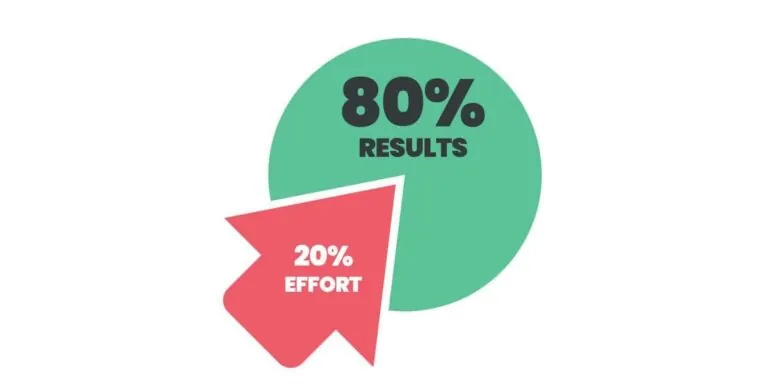What If I told you you’re wasting 80% of your time?
Ok, maybe that’s an exaggeration, but the Pareto Principle, more commonly known as the 80/20 rule, does give us some clues as to where we can find more efficiency in our time management.
But what exactly is this principle? And how can you apply it to boost efficiency in your everyday life?
This Article Covers:
- What Is The Pareto Principle?
- The Origins of the Pareto Principle
- Benefits of The Pareto Principle
- Examples of the Pareto Principle in Practice
- Flexibility of the Pareto Principle
- Are You In The 80 Percent or The 20 Percent?
- Famous People Who Swear by the Pareto Principle
- How to Apply The Pareto Principle in Your Life
- Final Thoughts
What Is the Pareto Principle?
The Pareto principle is a concept that suggests that roughly 80% of results come from 20% of our actions. While the exact ratio may not always be precisely 80/20, the fundamental idea remains the same: a small portion of your efforts often generates the majority of your success.
The core philosophy of the Pareto Principle is that not all efforts are equal. Some actions have a disproportionately large impact, while others contribute relatively little to the overall outcome.
This means that if you can identify the crucial 20% of activities that lead to the biggest results, you can maximize efficiency and effectiveness in your work, studies, and personal life.
The Origins of the Pareto Principle
Believe it or not, the Pareto Principle started in a garden. In the late 19th century, Italian economist Vilfredo Pareto noticed something interesting while tending to his pea plants. He observed that roughly 20% of the pea pods in his garden produced about 80% of the peas.
This got him thinking: could this pattern exist elsewhere? Pareto extended his observations to economics and discovered a striking similarity – about 80% of Italy’s land was owned by just 20% of the population.
Over time, other researchers and business professionals started seeing this pattern in different areas of life and work. From sales to sports, software development to media influence, the 80/20 rule seemed to apply almost everywhere.

(breeze.pm)
Benefits of The Pareto Principle
If you’re someone who feels constantly busy but not particularly productive, the Pareto Principle is about to become your new best friend. Understanding it can help you prioritize, improve efficiency, and reduce stress. But what are the benefits that it can bring?
- Get More Done in Less Time: Here’s the deal – not all tasks are created equal. If you’re always busy but never feel like you’re getting ahead, it might be because you’re spending time on things that don’t move the needle. The Pareto Principle helps you figure out what really makes a difference. By focusing on the 20% of tasks that lead to 80% of your results, you can accomplish more in less time.
- Reduce Stress and Overwhelm: We all know the feeling – there’s so much to do, and it feels like you’ll never catch up. By identifying the tasks that cause the most frustration or drain your energy, you can decide whether to eliminate them, delegate them, or find ways to make them easier.
- Improve Decision-Making: The 80/20 rule helps you make smarter decisions about where to invest your time, money, and energy. If you can pinpoint the 20% of actions that give you the biggest return, you can make choices that lead to bigger rewards without wasting resources on less effective efforts.
- Time Management: Tracking time is the key to unlocking the true potential of the Pareto Principle. The beauty of managing and recording your time effectively is that it helps you identify where you’re spending your energy and pinpoint the tasks that matter most. Once you know which 20% of your tasks are driving 80% of your results, you can prioritize them and let go of those time-wasters. You won’t know these insights unless you record and track your time.
Examples of the Pareto Principle in Practice
Ok, the Pareto principle sounds cool, but how can it help in real life? Let’s look at some examples:
#1 Business and work
If you run a business, a small percentage of your customers likely account for the majority of your revenue. This means that instead of trying to cater to every single customer equally, focusing on your most valuable clients can bring significantly better results.
By identifying these high-value customers and tailoring your products, services, and marketing strategies to their needs, you are more likely to maximize profitability and customer satisfaction with less effort.
#2 Studying
If you’re studying for an exam, focusing on the most frequently tested topics can give you the best return on your time investment. Instead of spreading your efforts thin over every possible subject, narrowing your focus to the core concepts will maximize your learning efficiency.
By reviewing past exams, identifying potential patterns, and emphasizing key topics, you can ensure that your study time is spent on material most likely to appear on the test.
#3 Health and Fitness
In health and fitness, just a few key exercises can lead to the majority of your goals. Decide on your targets, whether it be muscle gain, weight loss, or flexibility, and instead of attempting every exercise in the gym, concentrate on the exercises suited to your plan.
If you have ever tried searching online how to get healthy, you will quickly realize that there is an infinite number of ‘gurus’ telling you the ‘best’ method. If you try to follow them all you’ll never get anywhere. Instead, focus on a few goals that are most suited to your targets, and you will have a better chance of realizing results.
#4 Productivity and Time Management
If you’re trying to boost productivity, pinpointing a few key tasks that drive the most progress can help you achieve better results with less effort. By identifying and prioritizing these high-impact tasks, you can avoid wasting time on less important activities.
This approach allows you to channel your energy into work that truly matters, resulting in faster progress and a greater sense of accomplishment.
To help boost your time management, consider using a productivity tracker app to record your efforts, and manage results.
The list goes on and on. But the real question is: how can you use this knowledge to improve your life?

(unsplash.com)
Flexibility of the Pareto Principle
It’s important to note that the 80/20 ratio isn’t fixed – sometimes, it might be 90/10 or 70/30. The principle is more about recognizing disproportionate results rather than sticking to exact numbers.
Think of it as a guideline rather than a strict formula; the key takeaway is that a small fraction of inputs often leads to a much larger impact on the results. The takeaway isn’t about exact numbers but rather about recognizing an imbalance in effort versus results.
The more you become aware of this principle, the better you can fine-tune your focus to maximize outcomes. You will notice that in different areas of life, the ratios shift – some projects may see 90% of results coming from 10% of efforts, while others may have a more balanced 70/30 distribution.
This flexibility makes the Pareto Principle a useful tool for adjusting strategies based on real-world observations rather than rigid structures.
Are You In The 80 Percent or The 20 Percent?
Let’s look at some signs that you’re in the 80% (the not-so-productive zone) vs. the 20% (the high-impact, focused zone):
| You’re in the 80 Percent | You’re in the 20 Percent |
| Your to-do list is a mile long. | You focus on activities that align with your strengths. |
| You’re stuck doing something you really don’t enjoy or aren’t great at. | Your work is exciting and contributes to your personal growth. |
| Tasks take much longer than expected. | You delegate lower-priority tasks easily. |
| You’re constantly putting out fires. | You’re focused on what really drives results. |
| You’re feeling like a hamster on a wheel, constantly moving but not making progress. | You have the bandwidth to think and relax. |
| Your inbox is full of emails marked as “urgent,” but they’re mostly asking for small updates. | You’ve planned your day so that, after a productive morning, you can take a break. |
Famous People Who Swear by the Pareto Principle
Let’s take a closer look at how some top leaders use the Pareto Principle to make their lives and businesses run smoother. These guys aren’t just busy – they’re super productive, and it’s all because they know where to focus their time and energy. Here’s how they make the 80/20 rule work for them:
- Richard Koch – Author of The 80/20 Principle
Richard Koch turned the Pareto Principle into a full-blown philosophy for business and life.
Koch applies the rule to his business ventures by focusing on a few key areas that have the biggest return on investment. He recommends spending time on the 20% of activities that are most important and getting rid of the rest. - Tim Ferriss – Author of The 4-Hour Workweek
Tim Ferriss is all about working smarter, not harder. In his book In The 4-Hour Workweek, he breaks down how to do more with less. He applies the 80/20 rule by identifying the tasks that give him the biggest results and cutting out everything else. - Warren Buffett – Investor Extraordinaire
Warren Buffett, one of the most successful investors in the world, has a strategy that’s basically built around the 80/20 rule. Instead of investing in thousands of stocks, he focuses on a small number of high-impact investments that he believes will give him the biggest return. He doesn’t spread himself thin. He zeroes in on what’s most valuable.
So, What Can We Learn from These Leaders?
These successful people are all about doing less to achieve more. They’ve figured out that spending your time on the few things that really matter is the key to success. Instead of getting bogged down by busy work, they focus on what will move the needle the most.
Bonus Joke: Tim Ferriss, Richard Koch, and Warren Buffett walk into a bar for a business meeting. Ferriss orders a drink but only stays for a few minutes because any longer would push him over the 4-hour work week. Koch sips his wine and hands the rest back to the bar saying, “I only need to drink 20% of this to enjoy it”.
Buffett just smiles, sits back and says, “I bought this bar 20 years ago, I don’t care what you do with your drinks – cheers, gentlemen.”
How to Apply The Pareto Principle in Your Life
So, you’re ready to start working smarter, not harder? Here’s a simple 4-step process to get you on track with the Pareto Principle. Think of it as your roadmap to a more focused, productive life:
- Spot your power moves and figure out what’s really driving success.
- Prioritize the things that truly matter.
- Let go of the rest – delegate or eliminate those non-essentials.
- Keep adjusting and making improvements as you go.
Bonus tip: Start small. You don’t have to overhaul your whole life in one day. Pick one area – whether it’s work, fitness, or time management – and begin applying the Pareto Principle. You might just discover that the less you do, the more you get done!
Final Thoughts
Now that you know the signs, it’s time to ask yourself: are you spending most of your time in the 80%, doing tasks that drain you and don’t move the needle? Or are you in the 20%, where you’re focused on what matters most and enjoying the results of your efforts?
If your day feels like a series of mini-crises with little time for the big stuff, you might be caught in the 80%. But if your day feels aligned with your strengths, your tasks are energizing, and you have time to breathe, then congratulations – you’re in the 20%!
However, the Pareto Principle isn’t just a productivity hack – it’s a mindset shift. It helps you stop sweating the small stuff and start focusing on what truly matters.
They say that most of your phone battery is drained by just a few apps. The human brain is no different. By applying the 80/20 rule, you can work smarter, reduce stress, and make meaningful progress toward your goals with less effort. So, why keep wasting time on the unimportant 80%? Start identifying your high-impact 20% and take your efficiency to the next level!



